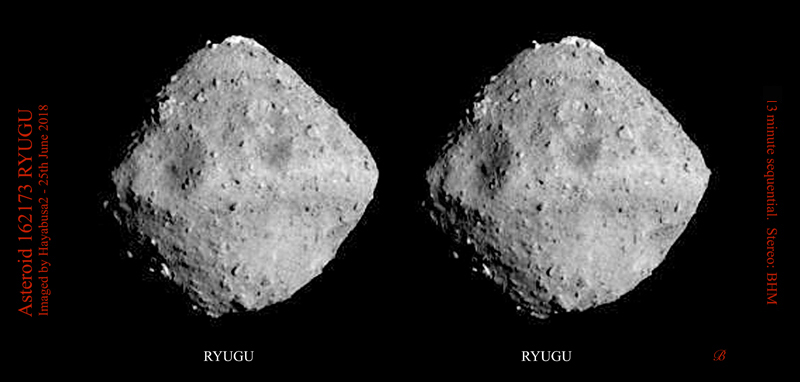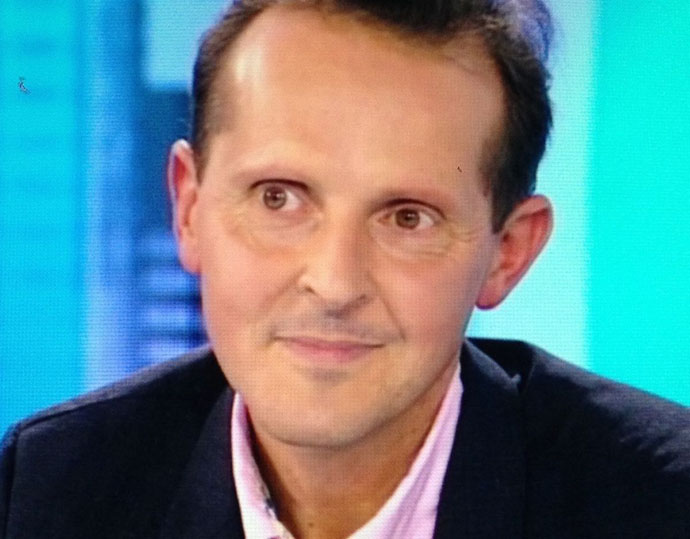Luxemburger Wort [WISSEN & FORSCHUNG] – p57
Thursday, 28. June2018
When the sky falls on our heads …
Interview with astrophysicist Patrick Michel on the occasion of the International Asteroid Day
Video auf
www.wort.lu

INTERVIEW: MANON KRAMP
Raising public awareness of the risks of asteroid impact, but also informing them of the potential of these celestial bodies – this is the goal of the International Asteroid Day proclaimed by the UN General Assembly in 2016. The date set on June 30 commemorates the Tunguska event on June 30, 1908, over Siberia. A disaster, which devastated more than 2 000 km2 of forest.
The French astrophysicist [Dr] Patrick Michel is one of the scientists present at the events organized in Luxembourg during the “Asteroid Day 2018”. We asked him to enlighten us as to the nature of the asteroids and the dangers they represent.
Patrick Michel, what is an asteroid?
An asteroid is a pebble that can have a size of ten metres to the largest, Ceres, which is 950 kilometres in diameter. Most of them are now located between Mars and Jupiter, in the main belt where all these small objects that are the remains of the materials that formed the planets reside. About 4.5 billion years ago, our solar system was a disk of gauze and dust surrounding our star, the sun. These dusts accumulated to form larger and larger bodies and some ended up in planets. But some of this dust has agglomerated between Mars and Jupiter.

What are these celestial objects made of?
There are different types of asteroids composed of different elements. There are two main classes: those of type F, which are rocky asteroids, rich in silicates, olivine and pyroxenes. We also have class C, bodies rich in carbon materials and therefore potentially organic matter. The latter are of particular interest to us because they are thought to be the most primitive and their composition is the most faithful to the original composition of the solar system. There are still other subclasses and some metallic bodies, which may be the remains of objects with a metal core, a mantle and a crust like the Earth, but destroyed in collisions.
Asteroids reveal astonishing information …
If we want to understand the initial composition of this nebula in which the planets were formed, we will not achieve it with terrestrial materials because the Earth is very big and there have been processes of heating and erosion. Asteroids have remained small enough that their position has not changed since the first moments of the solar system. By studying them, we go back in time and we access the initial ingredients that allowed the formation of the planets. Scenarios that have been developed in Nice say, that at the end of the formation of the Earth there are many impacts and it is possible, that it is the asteroids which brought there the water and the organic matter which allowed the emergence of life.
Where do the objects that cross the path of the Earth come from?
In unstable areas there are collisions and from time to time there are fragments of bodies that are ejected by its mechanisms. Some of them, the NEOs, cut the Earth’s orbit and can collide with it.
What is the most threatening asteroid for Earth at the moment?
We follow all the long-term objects to clarify their trajectory. For the asteroid Apophis, for example, the probability of collision with the Earth has been excluded. In 2029 it will pass very close to about 36,000 kilometres, which is the orbit of geostationary satellites. This will allow us to really study it. But for now, there is no object that threatens us – thankfully!
Are there regions that are more threatened by impacts than others?
No, the risk is completely random.
What are the devices for detecting and monitoring potentially dangerous asteroids?
Unfortunately, there is no dedicated program for now. Most of the discoveries are made from the ground, essentially by two large telescopes on Hawaii and Arizona. When we find an object, we also have a good movement on the side of the amateurs who follow it and allow to refine the orbit. More than 90 per cent of objects larger than one kilometre in diameter have been identified. The impact of a body of such a size would cause a catastrophe on a global scale. There are now objects larger than a hundred metres. But from the ground, we have little information to calculate a trajectory and as for the physical properties and the composition of an asteroid, it remains very summary.
And what would be the ideal solution?
The best way would be a space observatory like the Neocam project (Near-Earth Object Camera), which NASA is studying.
In the film “Armageddon”, Bruce Willis explodes an asteroid that is likely to hit the Earth. What are the real scenarios to ward off such a danger?
With the ESA European Space Agency, and NASA, we had studied an asteroid deflection test consisting of a high-speed projectile that hits this asteroid and deviates it from its trajectory. Already in 2016, ESA Director General Jan Wörner proposed this project to ESA member states. We had to make the orbiter and NASA the projectile. But despite the superb speech of the Deputy Prime Minister of Luxembourg, Etienne Schneider, it was not possible to collect sufficient funds. However, there is such a demand from some member states that we have been asked – I say we because I am the scientific leader of the project – to work on an optimized version of the mission to resubmit it to the Ministerial Council of ESA 2019. So there is a real project under consideration. It is hoped that Europe will not give up, because NASA has just made a report from the White House with a Road Map for planetary defence against asteroids, asking that this be done in international cooperation. We had built this project together and it would be interesting to be able to accompany the deviation test. This project is expected to occur in 2022.
What are the stakes of Asteroid Day?
Initially, the goal was to raise awareness of the existence of these objects and the risks they entail. Then, some scientists like me, made this message more positive by also emphasizing what the asteroids bring us scientifically. The risk exists, but it is very low compared to other natural risks. Moreover, we can predict it and we have solutions. It is now sufficient to implement them.
The public interest for these topics is there …
Yes, because we have new things to show with, in addition, missions to Indiana Jones, because they are always complicated adventures. For the moment, two important space missions are in progress. The Hayabusa2 mission has just arrived on the Ryugu NEO and will deploy a small harvester to collect a sample of dust. Hayabusa2 has already been able to provide us with the first detailed images ever made of a carbon asteroid. The NASA Osirix-Rex mission will arrive in mid-August on the asteroid Bennu to collect samples. Whether for science or planetary defence: these missions allow people to dream a little. — – – – –
* Patrick Michel is an astrophysicist, Research Director at the National Centre for Scientific Research and Head of the Planetology Group of the Lagrange Laboratory of the Côte d’Azur Observatory.
Events of “Asteroid Day 2018”
The Asteroid Foundation hosted in Luxembourg is organizing a series of events. From June 29 to July 1, debates and interviews with experts, scientists and astronauts are broadcast live on www.asteroidday.org from the Broadcasting Center Europe in Kirchberg. Deputy Prime Minister and Economy Minister Etienne Schneider will discuss the topic of asteroids and their potential on Friday 29 June at 16.00 with ESA Director General Jan Wörner.
Saturday, June 30, between 14.00 and 15.30 hours, the Ministry of Economy invites the public to meet four astronauts and experts in planetary sciences, including Patrick Michel, Cercle Cite, place d’Armes in Luxembourg. The Luxembourg Science Center and Mr Science offer a workshop and a virtual reality stand. Access is free.
* bit.ly/2Kk70qz
On June 30th, Matt Dawson, Research Associate of the Department of Astrophysics at the National Museum of Natural History, will hold a conference on asteroids from 3 to 5 pm at Naturmuseum, 25, rue Münster, Luxembourg.
* bit.ly/2lC0bmf
Events around the world
* #AsteroidDayLive